Accove Pty Ltd: ERP System Analysis and Information Gathering Report
VerifiedAdded on 2022/09/28
|9
|1577
|22
Report
AI Summary
This report, prepared for Accove Pty Ltd, details the process of identifying information repositories, reviewing organizational documentation, and developing critical questions to gather data for a new Enterprise Resource Planning (ERP) system. As a newly hired IT project manager, the author outlines the current information repositories, including helpdesk records, policy statements, data entry forms, training manuals, performance reports, and the company website. The report reviews organizational documentation and charts, including the roles of senior, middle, and operational management. It then develops open and closed-ended questions for stakeholders, particularly the CFO, to assess the current system's limitations and gather requirements for the new ERP system, addressing issues like cloud ERP as a business continuity strategy and data source validation. The goal is to replace the aging Microsoft Access Database with an efficient system that accommodates all departments.
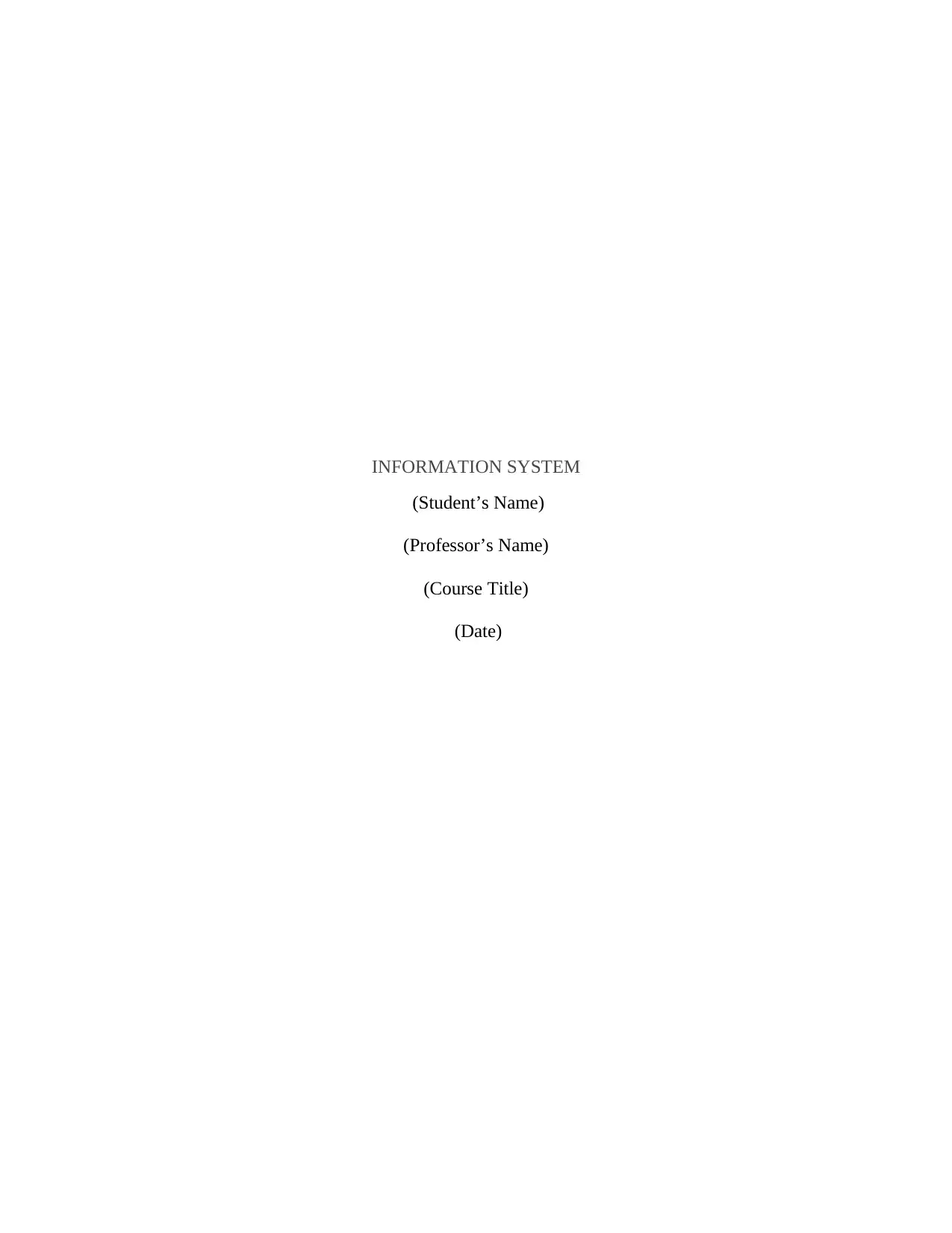
INFORMATION SYSTEM
(Student’s Name)
(Professor’s Name)
(Course Title)
(Date)
(Student’s Name)
(Professor’s Name)
(Course Title)
(Date)
Paraphrase This Document
Need a fresh take? Get an instant paraphrase of this document with our AI Paraphraser
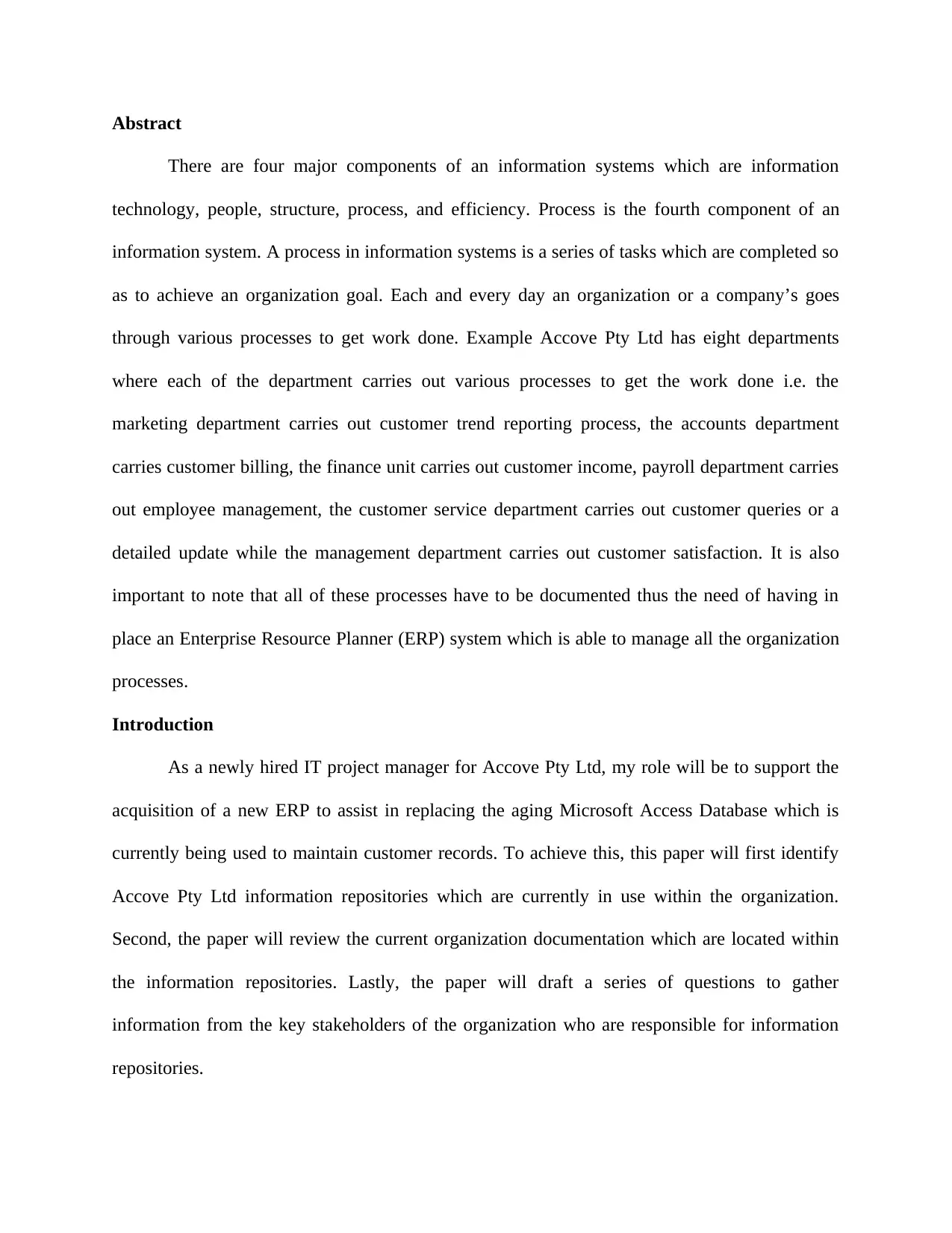
Abstract
There are four major components of an information systems which are information
technology, people, structure, process, and efficiency. Process is the fourth component of an
information system. A process in information systems is a series of tasks which are completed so
as to achieve an organization goal. Each and every day an organization or a company’s goes
through various processes to get work done. Example Accove Pty Ltd has eight departments
where each of the department carries out various processes to get the work done i.e. the
marketing department carries out customer trend reporting process, the accounts department
carries customer billing, the finance unit carries out customer income, payroll department carries
out employee management, the customer service department carries out customer queries or a
detailed update while the management department carries out customer satisfaction. It is also
important to note that all of these processes have to be documented thus the need of having in
place an Enterprise Resource Planner (ERP) system which is able to manage all the organization
processes.
Introduction
As a newly hired IT project manager for Accove Pty Ltd, my role will be to support the
acquisition of a new ERP to assist in replacing the aging Microsoft Access Database which is
currently being used to maintain customer records. To achieve this, this paper will first identify
Accove Pty Ltd information repositories which are currently in use within the organization.
Second, the paper will review the current organization documentation which are located within
the information repositories. Lastly, the paper will draft a series of questions to gather
information from the key stakeholders of the organization who are responsible for information
repositories.
There are four major components of an information systems which are information
technology, people, structure, process, and efficiency. Process is the fourth component of an
information system. A process in information systems is a series of tasks which are completed so
as to achieve an organization goal. Each and every day an organization or a company’s goes
through various processes to get work done. Example Accove Pty Ltd has eight departments
where each of the department carries out various processes to get the work done i.e. the
marketing department carries out customer trend reporting process, the accounts department
carries customer billing, the finance unit carries out customer income, payroll department carries
out employee management, the customer service department carries out customer queries or a
detailed update while the management department carries out customer satisfaction. It is also
important to note that all of these processes have to be documented thus the need of having in
place an Enterprise Resource Planner (ERP) system which is able to manage all the organization
processes.
Introduction
As a newly hired IT project manager for Accove Pty Ltd, my role will be to support the
acquisition of a new ERP to assist in replacing the aging Microsoft Access Database which is
currently being used to maintain customer records. To achieve this, this paper will first identify
Accove Pty Ltd information repositories which are currently in use within the organization.
Second, the paper will review the current organization documentation which are located within
the information repositories. Lastly, the paper will draft a series of questions to gather
information from the key stakeholders of the organization who are responsible for information
repositories.
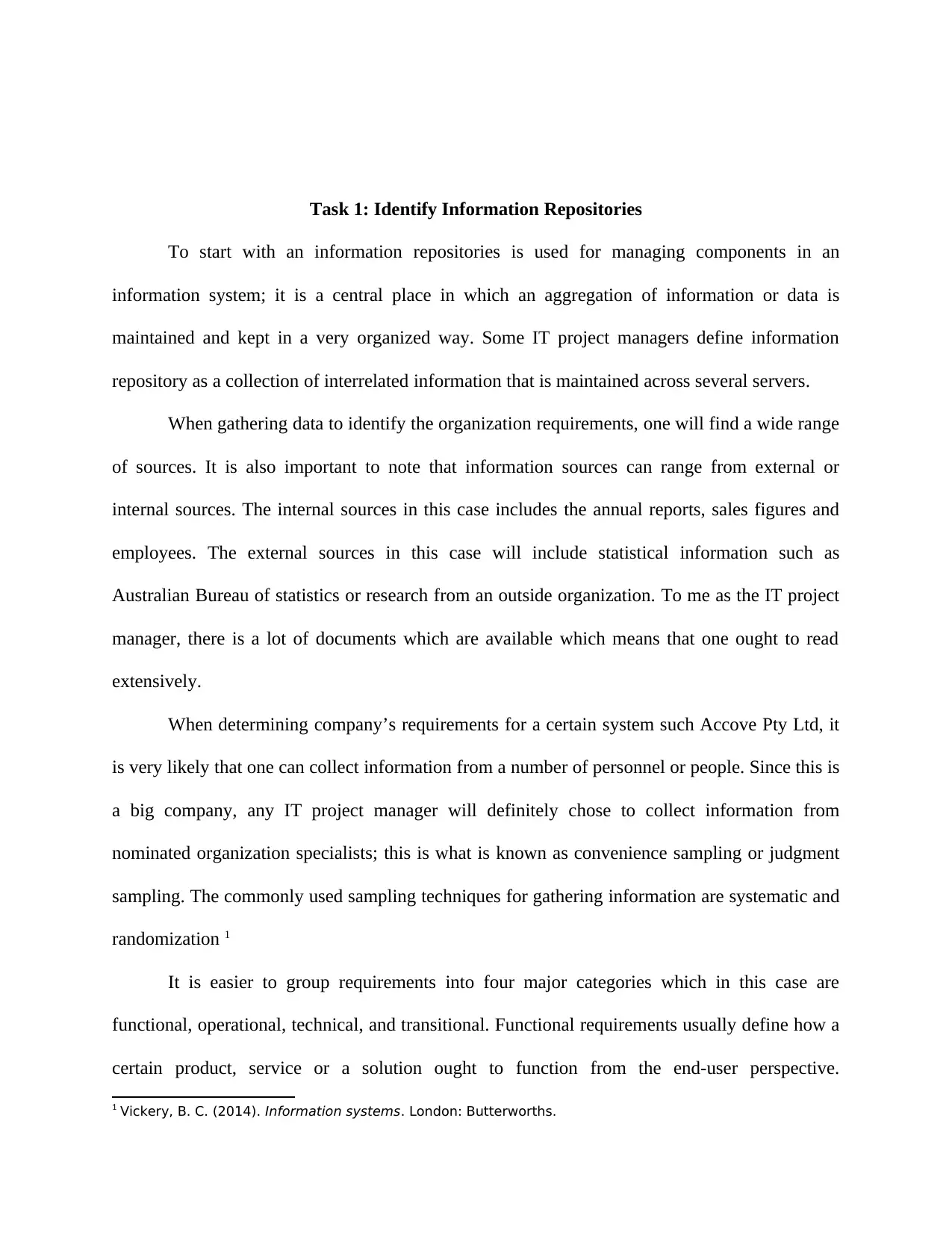
Task 1: Identify Information Repositories
To start with an information repositories is used for managing components in an
information system; it is a central place in which an aggregation of information or data is
maintained and kept in a very organized way. Some IT project managers define information
repository as a collection of interrelated information that is maintained across several servers.
When gathering data to identify the organization requirements, one will find a wide range
of sources. It is also important to note that information sources can range from external or
internal sources. The internal sources in this case includes the annual reports, sales figures and
employees. The external sources in this case will include statistical information such as
Australian Bureau of statistics or research from an outside organization. To me as the IT project
manager, there is a lot of documents which are available which means that one ought to read
extensively.
When determining company’s requirements for a certain system such Accove Pty Ltd, it
is very likely that one can collect information from a number of personnel or people. Since this is
a big company, any IT project manager will definitely chose to collect information from
nominated organization specialists; this is what is known as convenience sampling or judgment
sampling. The commonly used sampling techniques for gathering information are systematic and
randomization 1
It is easier to group requirements into four major categories which in this case are
functional, operational, technical, and transitional. Functional requirements usually define how a
certain product, service or a solution ought to function from the end-user perspective.
1 Vickery, B. C. (2014). Information systems. London: Butterworths.
To start with an information repositories is used for managing components in an
information system; it is a central place in which an aggregation of information or data is
maintained and kept in a very organized way. Some IT project managers define information
repository as a collection of interrelated information that is maintained across several servers.
When gathering data to identify the organization requirements, one will find a wide range
of sources. It is also important to note that information sources can range from external or
internal sources. The internal sources in this case includes the annual reports, sales figures and
employees. The external sources in this case will include statistical information such as
Australian Bureau of statistics or research from an outside organization. To me as the IT project
manager, there is a lot of documents which are available which means that one ought to read
extensively.
When determining company’s requirements for a certain system such Accove Pty Ltd, it
is very likely that one can collect information from a number of personnel or people. Since this is
a big company, any IT project manager will definitely chose to collect information from
nominated organization specialists; this is what is known as convenience sampling or judgment
sampling. The commonly used sampling techniques for gathering information are systematic and
randomization 1
It is easier to group requirements into four major categories which in this case are
functional, operational, technical, and transitional. Functional requirements usually define how a
certain product, service or a solution ought to function from the end-user perspective.
1 Vickery, B. C. (2014). Information systems. London: Butterworths.
⊘ This is a preview!⊘
Do you want full access?
Subscribe today to unlock all pages.

Trusted by 1+ million students worldwide
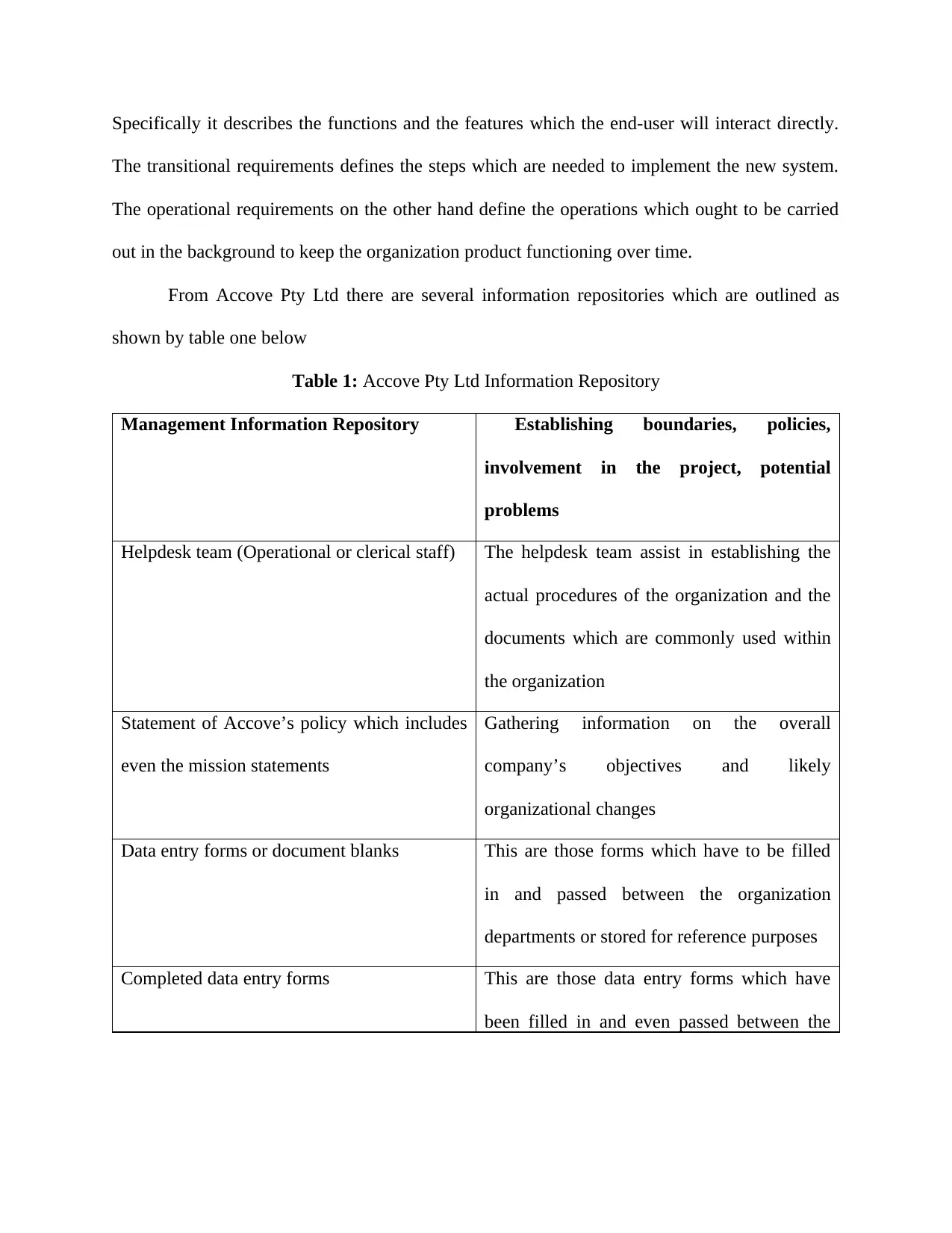
Specifically it describes the functions and the features which the end-user will interact directly.
The transitional requirements defines the steps which are needed to implement the new system.
The operational requirements on the other hand define the operations which ought to be carried
out in the background to keep the organization product functioning over time.
From Accove Pty Ltd there are several information repositories which are outlined as
shown by table one below
Table 1: Accove Pty Ltd Information Repository
Management Information Repository Establishing boundaries, policies,
involvement in the project, potential
problems
Helpdesk team (Operational or clerical staff) The helpdesk team assist in establishing the
actual procedures of the organization and the
documents which are commonly used within
the organization
Statement of Accove’s policy which includes
even the mission statements
Gathering information on the overall
company’s objectives and likely
organizational changes
Data entry forms or document blanks This are those forms which have to be filled
in and passed between the organization
departments or stored for reference purposes
Completed data entry forms This are those data entry forms which have
been filled in and even passed between the
The transitional requirements defines the steps which are needed to implement the new system.
The operational requirements on the other hand define the operations which ought to be carried
out in the background to keep the organization product functioning over time.
From Accove Pty Ltd there are several information repositories which are outlined as
shown by table one below
Table 1: Accove Pty Ltd Information Repository
Management Information Repository Establishing boundaries, policies,
involvement in the project, potential
problems
Helpdesk team (Operational or clerical staff) The helpdesk team assist in establishing the
actual procedures of the organization and the
documents which are commonly used within
the organization
Statement of Accove’s policy which includes
even the mission statements
Gathering information on the overall
company’s objectives and likely
organizational changes
Data entry forms or document blanks This are those forms which have to be filled
in and passed between the organization
departments or stored for reference purposes
Completed data entry forms This are those data entry forms which have
been filled in and even passed between the
Paraphrase This Document
Need a fresh take? Get an instant paraphrase of this document with our AI Paraphraser
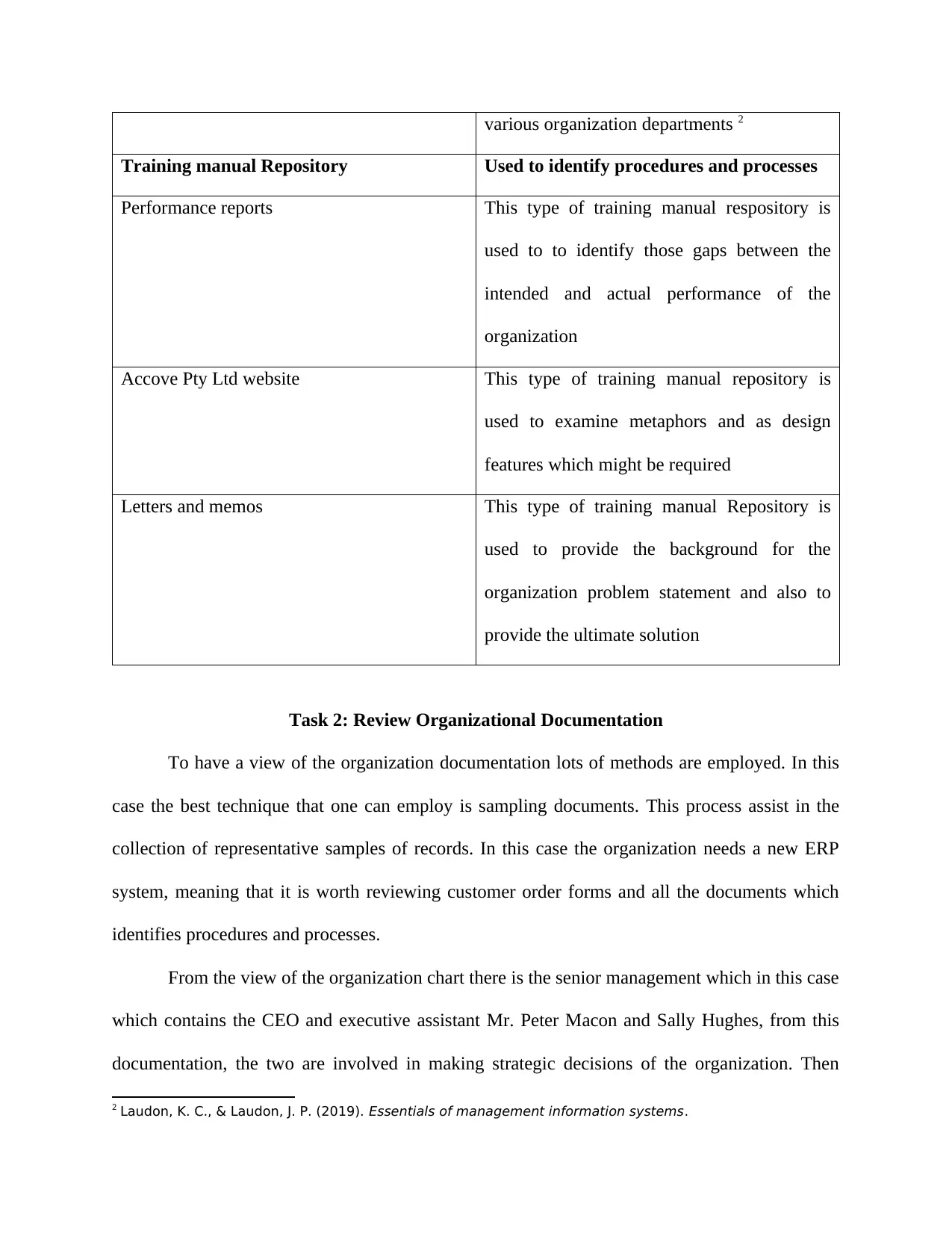
various organization departments 2
Training manual Repository Used to identify procedures and processes
Performance reports This type of training manual respository is
used to to identify those gaps between the
intended and actual performance of the
organization
Accove Pty Ltd website This type of training manual repository is
used to examine metaphors and as design
features which might be required
Letters and memos This type of training manual Repository is
used to provide the background for the
organization problem statement and also to
provide the ultimate solution
Task 2: Review Organizational Documentation
To have a view of the organization documentation lots of methods are employed. In this
case the best technique that one can employ is sampling documents. This process assist in the
collection of representative samples of records. In this case the organization needs a new ERP
system, meaning that it is worth reviewing customer order forms and all the documents which
identifies procedures and processes.
From the view of the organization chart there is the senior management which in this case
which contains the CEO and executive assistant Mr. Peter Macon and Sally Hughes, from this
documentation, the two are involved in making strategic decisions of the organization. Then
2 Laudon, K. C., & Laudon, J. P. (2019). Essentials of management information systems.
Training manual Repository Used to identify procedures and processes
Performance reports This type of training manual respository is
used to to identify those gaps between the
intended and actual performance of the
organization
Accove Pty Ltd website This type of training manual repository is
used to examine metaphors and as design
features which might be required
Letters and memos This type of training manual Repository is
used to provide the background for the
organization problem statement and also to
provide the ultimate solution
Task 2: Review Organizational Documentation
To have a view of the organization documentation lots of methods are employed. In this
case the best technique that one can employ is sampling documents. This process assist in the
collection of representative samples of records. In this case the organization needs a new ERP
system, meaning that it is worth reviewing customer order forms and all the documents which
identifies procedures and processes.
From the view of the organization chart there is the senior management which in this case
which contains the CEO and executive assistant Mr. Peter Macon and Sally Hughes, from this
documentation, the two are involved in making strategic decisions of the organization. Then
2 Laudon, K. C., & Laudon, J. P. (2019). Essentials of management information systems.
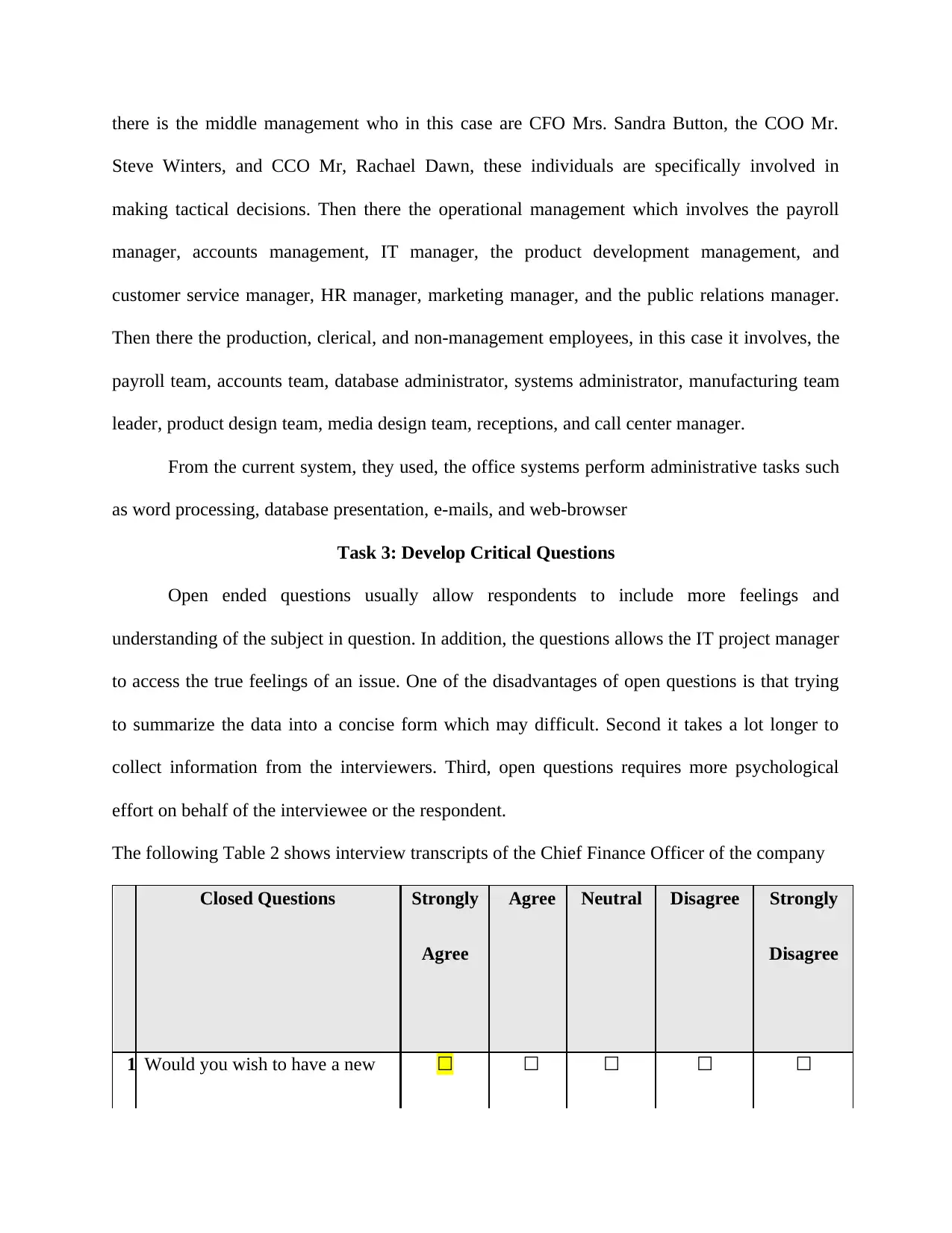
there is the middle management who in this case are CFO Mrs. Sandra Button, the COO Mr.
Steve Winters, and CCO Mr, Rachael Dawn, these individuals are specifically involved in
making tactical decisions. Then there the operational management which involves the payroll
manager, accounts management, IT manager, the product development management, and
customer service manager, HR manager, marketing manager, and the public relations manager.
Then there the production, clerical, and non-management employees, in this case it involves, the
payroll team, accounts team, database administrator, systems administrator, manufacturing team
leader, product design team, media design team, receptions, and call center manager.
From the current system, they used, the office systems perform administrative tasks such
as word processing, database presentation, e-mails, and web-browser
Task 3: Develop Critical Questions
Open ended questions usually allow respondents to include more feelings and
understanding of the subject in question. In addition, the questions allows the IT project manager
to access the true feelings of an issue. One of the disadvantages of open questions is that trying
to summarize the data into a concise form which may difficult. Second it takes a lot longer to
collect information from the interviewers. Third, open questions requires more psychological
effort on behalf of the interviewee or the respondent.
The following Table 2 shows interview transcripts of the Chief Finance Officer of the company
Closed Questions Strongly Agree Neutral Disagree Strongly
Agree Disagree
1 Would you wish to have a new ☐ ☐ ☐ ☐ ☐
Steve Winters, and CCO Mr, Rachael Dawn, these individuals are specifically involved in
making tactical decisions. Then there the operational management which involves the payroll
manager, accounts management, IT manager, the product development management, and
customer service manager, HR manager, marketing manager, and the public relations manager.
Then there the production, clerical, and non-management employees, in this case it involves, the
payroll team, accounts team, database administrator, systems administrator, manufacturing team
leader, product design team, media design team, receptions, and call center manager.
From the current system, they used, the office systems perform administrative tasks such
as word processing, database presentation, e-mails, and web-browser
Task 3: Develop Critical Questions
Open ended questions usually allow respondents to include more feelings and
understanding of the subject in question. In addition, the questions allows the IT project manager
to access the true feelings of an issue. One of the disadvantages of open questions is that trying
to summarize the data into a concise form which may difficult. Second it takes a lot longer to
collect information from the interviewers. Third, open questions requires more psychological
effort on behalf of the interviewee or the respondent.
The following Table 2 shows interview transcripts of the Chief Finance Officer of the company
Closed Questions Strongly Agree Neutral Disagree Strongly
Agree Disagree
1 Would you wish to have a new ☐ ☐ ☐ ☐ ☐
⊘ This is a preview!⊘
Do you want full access?
Subscribe today to unlock all pages.

Trusted by 1+ million students worldwide
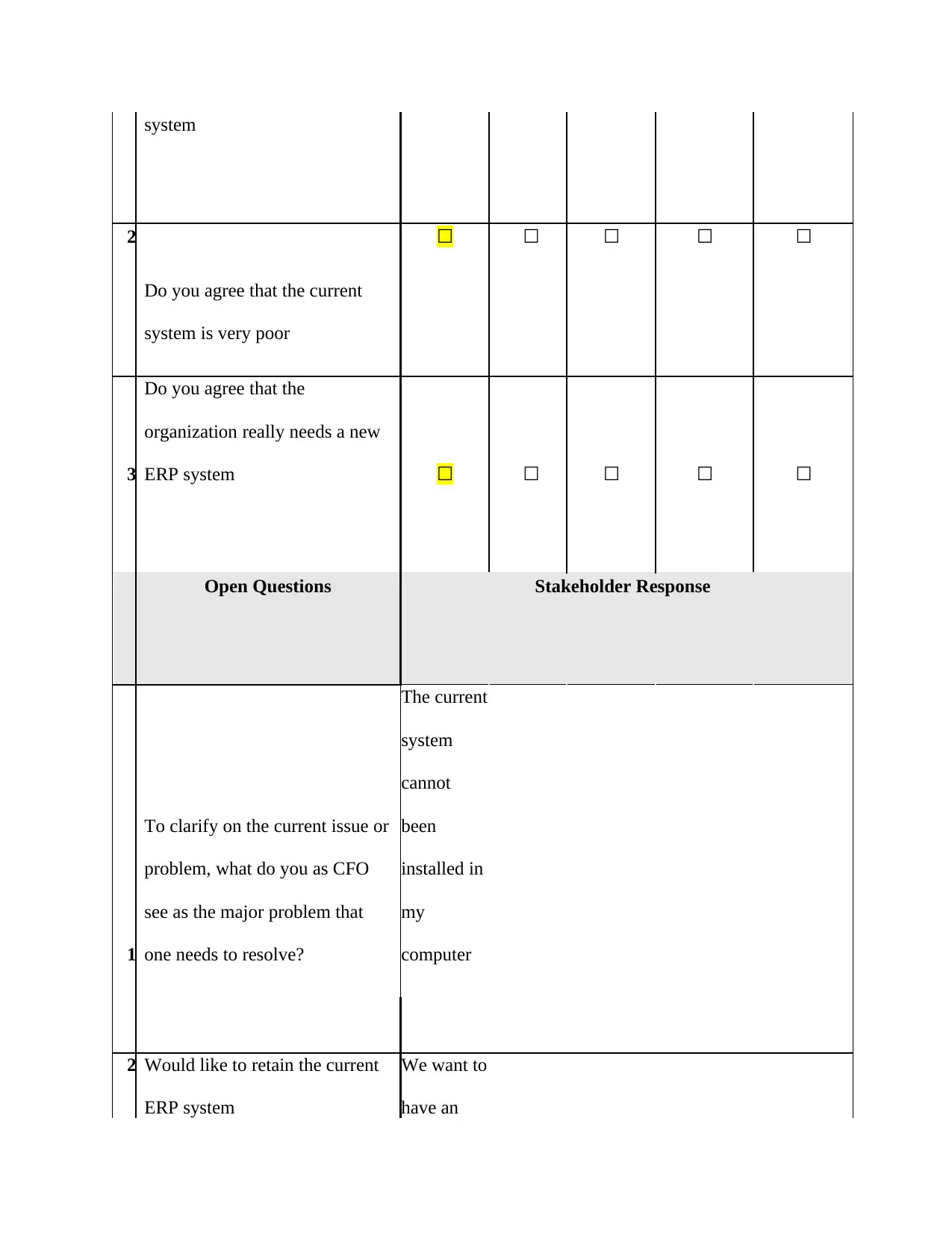
system
2 ☐ ☐ ☐ ☐ ☐
Do you agree that the current
system is very poor
3
Do you agree that the
organization really needs a new
ERP system ☐ ☐ ☐ ☐ ☐
Open Questions Stakeholder Response
1
To clarify on the current issue or
problem, what do you as CFO
see as the major problem that
one needs to resolve?
The current
system
cannot
been
installed in
my
computer
2 Would like to retain the current
ERP system
We want to
have an
2 ☐ ☐ ☐ ☐ ☐
Do you agree that the current
system is very poor
3
Do you agree that the
organization really needs a new
ERP system ☐ ☐ ☐ ☐ ☐
Open Questions Stakeholder Response
1
To clarify on the current issue or
problem, what do you as CFO
see as the major problem that
one needs to resolve?
The current
system
cannot
been
installed in
my
computer
2 Would like to retain the current
ERP system
We want to
have an
Paraphrase This Document
Need a fresh take? Get an instant paraphrase of this document with our AI Paraphraser
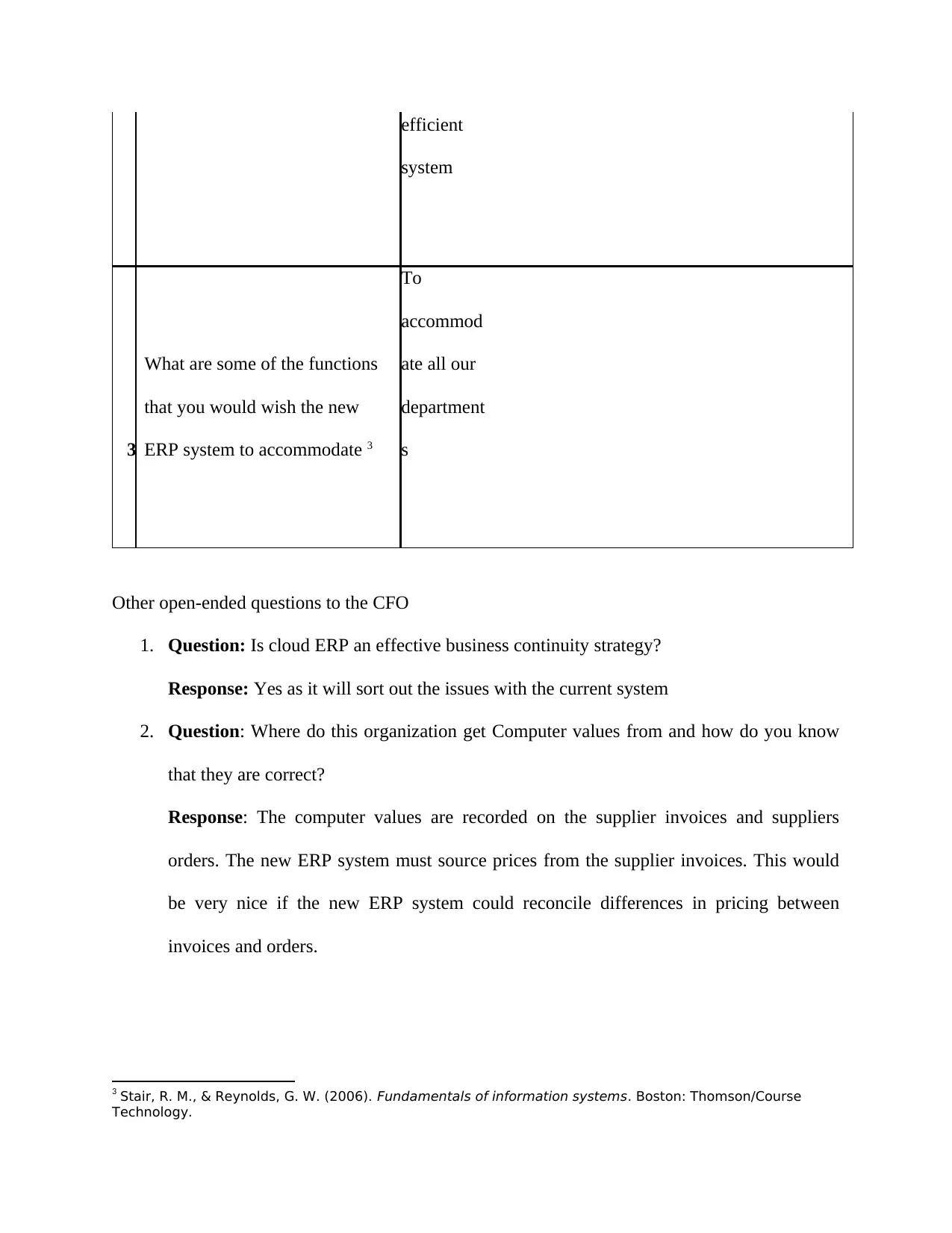
efficient
system
3
What are some of the functions
that you would wish the new
ERP system to accommodate 3
To
accommod
ate all our
department
s
Other open-ended questions to the CFO
1. Question: Is cloud ERP an effective business continuity strategy?
Response: Yes as it will sort out the issues with the current system
2. Question: Where do this organization get Computer values from and how do you know
that they are correct?
Response: The computer values are recorded on the supplier invoices and suppliers
orders. The new ERP system must source prices from the supplier invoices. This would
be very nice if the new ERP system could reconcile differences in pricing between
invoices and orders.
3 Stair, R. M., & Reynolds, G. W. (2006). Fundamentals of information systems. Boston: Thomson/Course
Technology.
system
3
What are some of the functions
that you would wish the new
ERP system to accommodate 3
To
accommod
ate all our
department
s
Other open-ended questions to the CFO
1. Question: Is cloud ERP an effective business continuity strategy?
Response: Yes as it will sort out the issues with the current system
2. Question: Where do this organization get Computer values from and how do you know
that they are correct?
Response: The computer values are recorded on the supplier invoices and suppliers
orders. The new ERP system must source prices from the supplier invoices. This would
be very nice if the new ERP system could reconcile differences in pricing between
invoices and orders.
3 Stair, R. M., & Reynolds, G. W. (2006). Fundamentals of information systems. Boston: Thomson/Course
Technology.
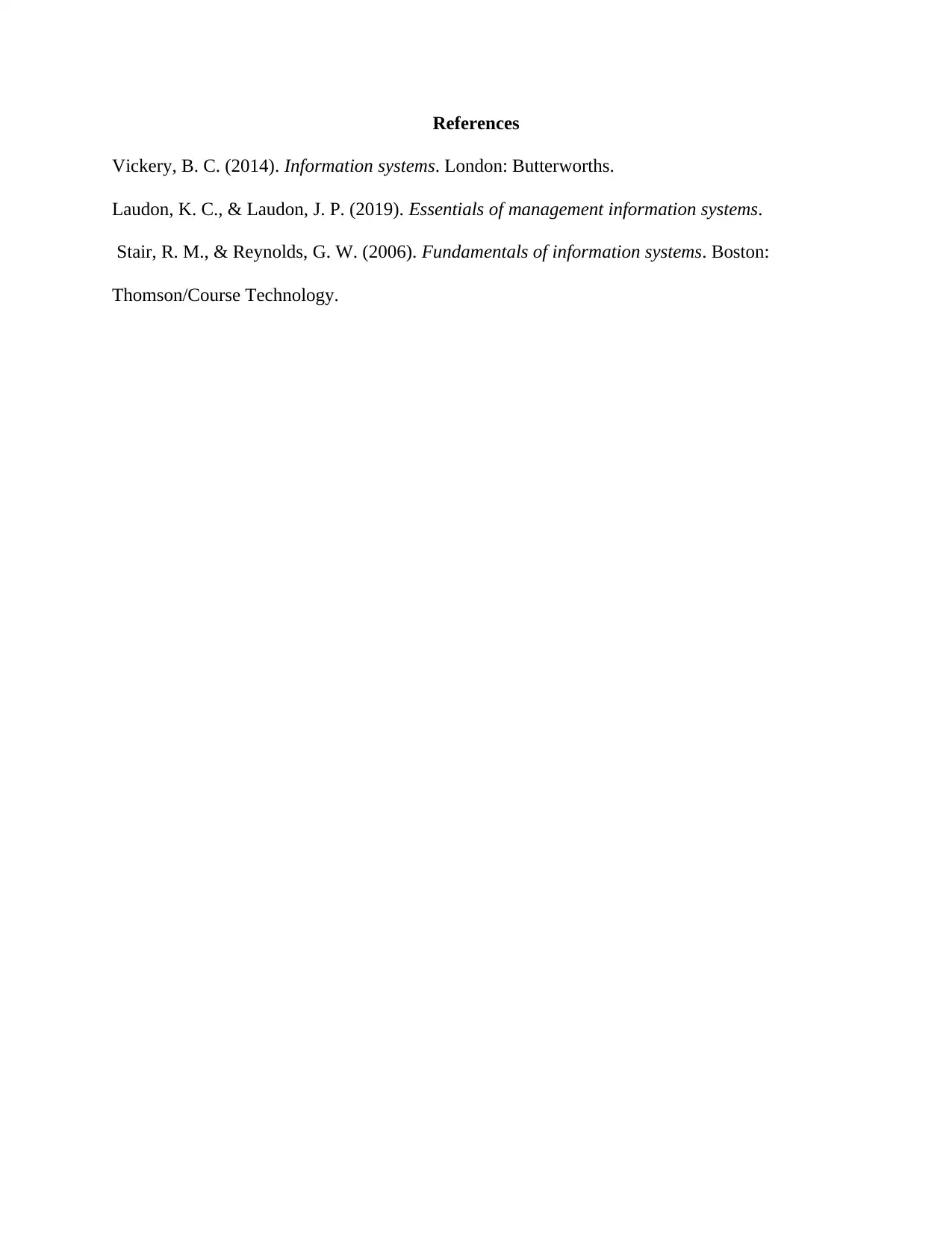
References
Vickery, B. C. (2014). Information systems. London: Butterworths.
Laudon, K. C., & Laudon, J. P. (2019). Essentials of management information systems.
Stair, R. M., & Reynolds, G. W. (2006). Fundamentals of information systems. Boston:
Thomson/Course Technology.
Vickery, B. C. (2014). Information systems. London: Butterworths.
Laudon, K. C., & Laudon, J. P. (2019). Essentials of management information systems.
Stair, R. M., & Reynolds, G. W. (2006). Fundamentals of information systems. Boston:
Thomson/Course Technology.
⊘ This is a preview!⊘
Do you want full access?
Subscribe today to unlock all pages.

Trusted by 1+ million students worldwide
1 out of 9
Related Documents
Your All-in-One AI-Powered Toolkit for Academic Success.
+13062052269
info@desklib.com
Available 24*7 on WhatsApp / Email
![[object Object]](/_next/static/media/star-bottom.7253800d.svg)
Unlock your academic potential
Copyright © 2020–2025 A2Z Services. All Rights Reserved. Developed and managed by ZUCOL.





